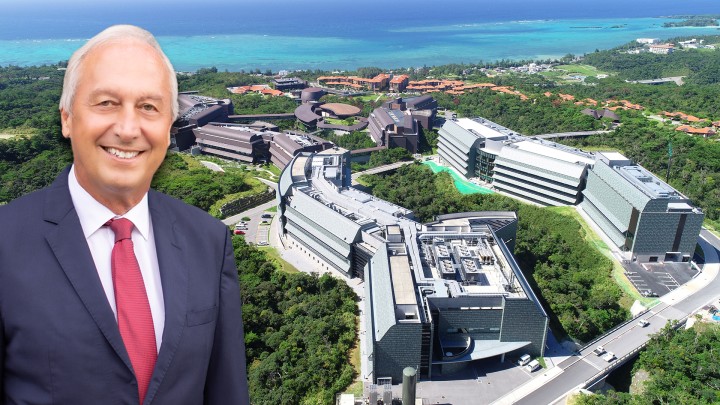Reaching for the Top in the World since the First Years of Its Establishment, OIST Attracts World Class Talent

The interview article published in "Monthly Advanced Education(月刊先端教育)" is translated by OIST and introduced here with permission.
Spearheaded by the Japanese government with the aim to create a world-leading institution in Japan, Okinawa Institute of Science and Technology Graduate University (OIST) was established. We caught up with Dr. Peter Gruss, the President of OIST from 2017 to learn of the unique characteristics and outlooks of OIST.
Attracting world-leading talent
How has COVID-19 affected education and society in general?
COVID-19 is the worst unexpected pandemic to happen in this century. Besides the loss of many lives, one of its direct impacts is the loss of jobs. In the United States, more than 12 million people are unemployed due to COVID-19. Governments are seeking to strike a balance between preventing the spread of the virus and reducing its deleterious impact upon the economy.
On the other hand, as the COVID-19 pandemic continues, augmented reality (AR), video conferencing and virtual technology are currently booming. Virtual technology is playing an important role in education. The pandemic has forced schools and kindergartens to close, yet a certain level of education still must be maintained. And this is where new technology has become indispensable.
Can you tell me the reason why OIST has been able to recruit talented people from all over the world?
The foremost mission of OIST is to become one of the top institutions in the world. Japan has 126 million people and the world has 7.6 billion. If you assume 2% of the world population consists of the most intelligent people, that means there are 2.5 million and 152 million of such people in Japan and the world, respectively. That is our incentive to look for people from all around the world.
From the very outset of 2012, OIST has been driven by high level of internationality: the requirement to hire at least 50% of the professors, staff and graduate students from overseas shows that OIST is seriously competing to attract a high level of talent from all over the world. Nine years into its establishment, more than 60% of professors and 80% of PhD students at OIST are non-Japanese. The influx of talent from abroad has led to OIST being rated as the top in Japan and ninth in the world for the number of high-quality science publications according to Springer Nature in 2019.
There are several criteria that attract talent.
First, the environment of OIST is very international. English is the common language by which education and research are conducted here.
Second, we employ high-trust funding, a system that provides funds for individuals in order to perform highly creative and innovative research. At OIST, we provide a research environment that allows researchers to be creative to work on their research for several years. Young professors, such as assistant professors, do not work under a more senior professor. Instead, OIST provides independent research opportunities. Even young researchers can be creative and independent in their research, which I believe is reflected in OIST’s rating.
Third, there are no barriers between the different fields at OIST. This allows us to have interdisciplinary education and research opportunities. OIST strongly encourages interdisciplinary dialogue and exchange of research expertise between the various research units. We provide venues for researchers to meet and collaborate with others in different fields.
Can you tell me what attracts students to come to OIST from all over the world?
OIST is a graduate university with a five-year PhD program.
Students come from more than 40 countries all over the world. To support such a diverse student body, OIST is insistent on maintaining an environment that does not discriminate based on countries of origin, genders, sexual identities, religions, disability status or social and economic backgrounds.
The ratio of professor to student is 1:3. All students are taught directly by top scientists.
The support package for an OIST student is substantial. In addition to the competitive financial support, OIST also helps with relocation, visa application, and campus housing. This assistance extends all the way to graduation.
At OIST, students will undergo lab rotations, in which the first-year students will experience three different research labs. This enables the students to explore different science fields to engage their creativity to create new sciences.
OIST also provides professional career development as a graduation requirement. Students are not only trained in scientific knowledge and practices but will also receive training to become effective members of the scientific community. They acquire soft skills that are applicable to any future career.
The most important thing is quality control
How are faculty research and educational activities evaluated?
Last year, OIST recruited 18 faculty members out of 1544 applicants, with a competitive acceptance rate of 1%. The applicants are screened on many levels. First, their applications including academic achievements and research plans are reviewed, then they go through a video conference. In the last step of the process, each applicant is asked to give a presentation at OIST. There is also an informal session called a chalk-talk, where the applicants are evaluated on how they are able to communicate complex information in a simple way to the students.
To ensure that professors are performing well, each unit is evaluated via unit review every five years. During the unit review, OIST brings five subject experts in the research field from around the world to evaluate the research and teaching ability of the faculty members. Following this strict evaluation, research support reduction or unit shutdown may happen if the faculty member is not performing as expected.
Can you give me some examples on what kind of research OIST has been working on?
OIST has been able to hire faculty members at the top level, but with only 80 faculty members, it is still currently a small university. Despite the size, we have been able to achieve some remarkable research results.
OIST has strong research units in Physics and Neurosciences and is actively strengthening its research capacity in other disciplines as well. Last year, we recruited new faculty members in chemistry and math. Through additional hiring, we have been assembling a top level unit in marine biology that is doing research on the ecology of coral reefs. We have also hired more scientists specializing in neuroscience as we anticipate this field to become an important platform for creating robots that can learn
At its current state, Japan has a shortage of 200,000 cybersecurity experts. We need to build up a unit that does research and education on quantum cybersecurity, possibly with our already strong quantum physics unit as a springboard.
OIST is an intellectual center
Fundraising is one of the challenges of universities. OIST has established the OIST Foundation in the U.S.
OIST is funded by the Cabinet Office, which allows us to operate high-trust funding, but in return it calls for a high level of research and technology transfer. Through high trust funding, faculty members receive five years of research funds to develop their science profiles. Continuing this system requires a great amount of funds.
OIST is now working to raise external funds up to 10% of the baseline budget. External funds include ones from corporation within the pertinent industries, collaboration with other universities or academic institutions and philanthropic donations. In Japan, there is no culture or philosophy surrounding philanthropy. When I was a postdoc in the United States, I saw everyone making routine donations at the end of the year. There was a basic philosophy of giving to someone, even if the amount of money is not large. That is why OIST established the OIST Foundation a year ago in the US, and the Foundation is having a great start. In the long run, I believe the Foundation would make a big contribution to OIST in helping to raise external income.
Please tell me about your initiatives regarding collaboration with industries and local communities.
Research, education through research and technology transfer are the three pillars for the mission of OIST. Through technology transfer, OIST aims to help with the development of Okinawa. The Technology Development and Innovation Center (TDIC) at OIST has the task of securing intellectual property, and it has already secured about 150 patents. TDIC manages the portfolio of intellectual property but also prototypes for products which may attract private company investments. Part of TDIC’s purpose is also to encourage entrepreneurships and startups and acquire funds from venture capitals.
At OIST, we have a number of collaborations with companies and other institutes, such as on sustainable energy with Sony, AI Robotics with Fujitsu, wave energy with a Japanese company, optics engineering with a German company, next generation battery with a UK company, etc. OIST is an intellectual center that generates new ideas and concepts which enable entrepreneurs to launch startup companies.
A university with great presence in the local community
Please tell me about the challenges faced by OIST
This does not only apply to OIST, but the major challenge is to get the money we need. Japan under-performs amongst the most advanced countries in the world when it comes to the amount of investment made for research and development. Only 0.65% of Japan’s GDP is being spent from the government earmarked for basic research and not just for corporate R&D. Germany spends 1% and the U.S. has spent nearly 0.9% until last year.
You must understand that, in order to sow the seed for new product development, investment on basic research is needed. Especially in the post-COVID-19 era, I believe that investments in R&D have become truly essential.
Also, entrepreneurship and venture capital have not taken root yet in Japan. Compared to the situation in the U.S., venture capital in Japan comprises only 3%. In the U.S., 75% of new jobs are created by new companies. We need to revive Japan’s economy with new companies, which are formed by new ideas coming from entrepreneurs and research in the universities. This is a very under-developed area in Japan.
As the third President of OIST, can you tell me about the outlook of OIST?
Recently, OIST invited several highly renowned, international scientific leaders to discuss the direction of its future portfolio. In 2017, we introduced the Perspective Council, where we invited Nobel laureates and directors from Max Planck Institutes to discuss with OIST faculty members on what direction in science should OIST take in the future.
Additionally, I have introduced the External Peer Review Committee, which examines with a bird’s-eye view the University’s performance instead of only looking at individual performances. These processes are how I balance the managerial as well as scientifically forward-looking tasks that OIST demands for success.
The mission of OIST rests upon the three pillars of research, education and technology transfer. For research as well as education, we must grow. Currently, we have 80 faculty members while the University of Tokyo has approximately 2,200 professorial staff and 300 lecturers. Our benchmark is the California Institute of Technology, which has about 360 faculty members. This is the goal for OIST to reach in the next 10 to 20 years. We also aim to increase the number of our students. We will have around 60 students coming to OIST every year for the PhD program, selected from more than 1500 applicants. We need to increase the number of faculty and students while maintaining the 1:3 ratio of faculty to student.
Also, we need to play a bigger role in the development for Okinawa. OIST has created a sizeable international community proportional to the local population here in Onna Village. However, people are still unaware of what we have been doing in Okinawa. We need to cultivate a greater presence by directly contributing to businesses in Okinawa. The COVID-19 pandemic has had a particularly negative impact upon Okinawa’s tourism, the biggest industry in Okinawa.
OIST can be a tool to diversify Okinawa’s economic base by helping to generate startups, which provide job options and attract other business services for employment besides tourism. We now have plans to build an innovation park on the lands next to our campus provided by Onna Village. We want to build something that is in harmony with nature, human well-being and technological innovation. That is our goal for the next decade.














